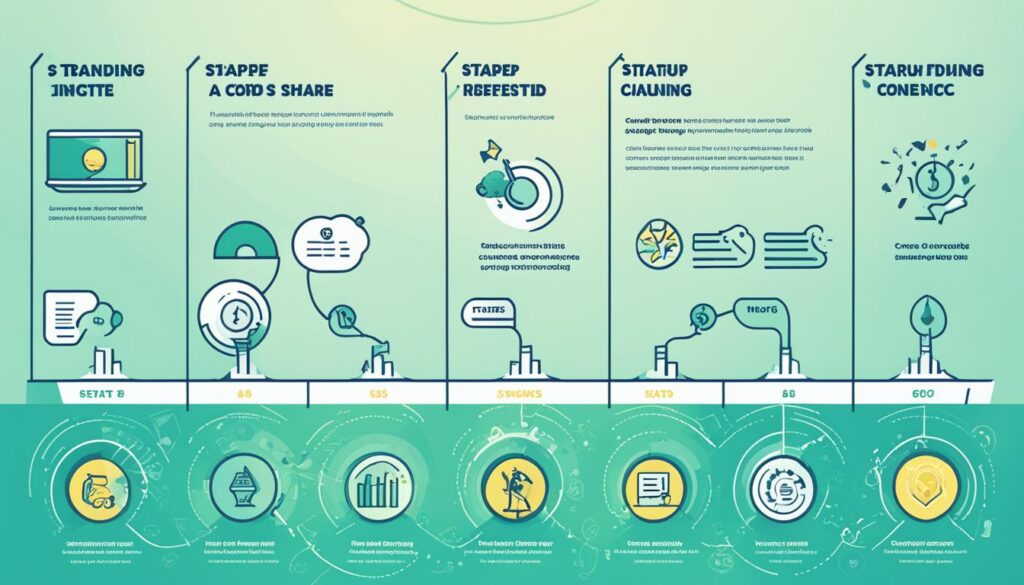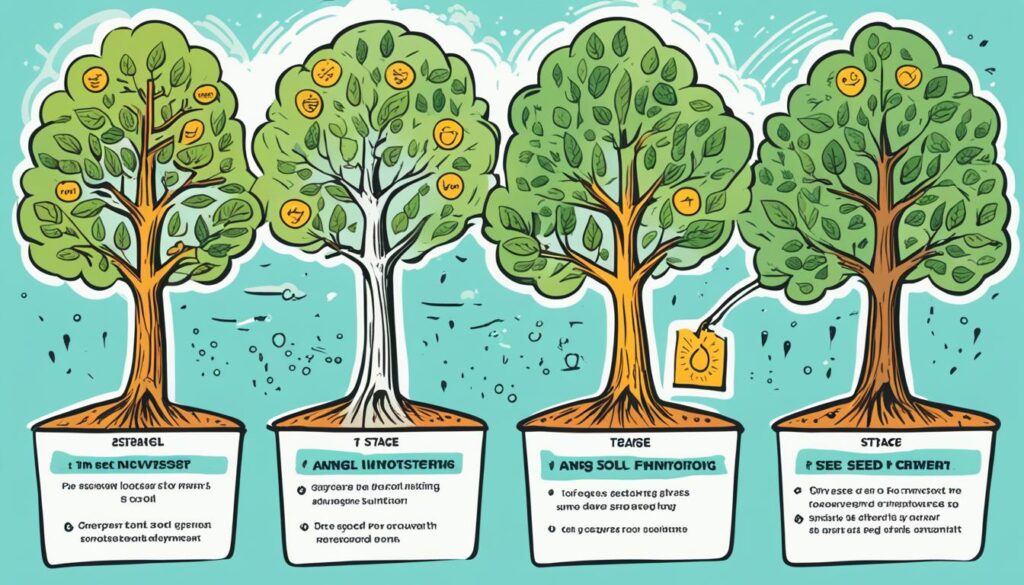Did you realize that almost half of startups fail due to running out of funds? This highlights the importance of funding in a startup’s path to success. In the rapidly changing business landscape, having a thorough understanding of funding is crucial for aspiring entrepreneurs. Our infographic provides a clear insight into funding, from the initial stages to Series C, outlining various avenues to secure the necessary capital.
Diving into this topic, it’s clear that the right investor funding can really set your startup on the path to success. Whether you’re just starting to look for funds or thinking about how to grow, our infographic is full of useful tips. It will help you find your way through the complex funding world with more confidence.
Key Takeaways
- Understanding startup funding is crucial for success.
- A significant percentage of startups fail due to financing issues.
- Infographics can simplify the complexities of funding stages.
- Pre-seed funding can range from $100,000 to $1 million.
- Less than 10% of startups successfully reach Series A funding.
- Investors often expect substantial returns, aiming for at least 50 times their investment.
- The current trend favors agile funding methods over long-term funding rounds.
Understanding Startup Funding Basics
Startup funding happens in stages, not all at once. You often start with personal funds or help from family. Startup funding basics show how to get financial support as you begin. This knowledge is vital for every new entrepreneur.
At first, a new company might get $15,000 from loved ones. This early money aids in refining the business concept. Then, an angel investor could add about $200,000 within three months. Networking is key to finding these initial investors.
Venture capitalists (VCs) usually step in as the company grows. They might put in about $2 million six months later. VCs invest big amounts, wanting a big share in return. In our scenario, a VC could take a 33.3% stake, valuing the startup at $4 million.
Making an impressive pitch deck is crucial. It must show market savvy and your vision as an entrepreneur. A good mix of storytelling and solid facts improves your odds of getting funded.
The Importance of a Solid Business Idea
A solid business idea is crucial for startups. It’s the foundation of your enterprise. Without it, getting investors is tough. At the start, startups often face hurdles due to few performance metrics. To succeed, you need to clearly share your vision and market knowledge.
Startup statistics show how hard success can be. About 20% of Canadian startups fail in their first year. Close to 60% don’t make it past three years. A major 38% close due to money problems or failing to get more funds. These facts show how important a solid idea and funding strategy are.
It’s key to attract investors. Angel investors often give between $25,000 to $100,000. With many small and medium businesses in Canada, your business idea needs to shine. You should point out what makes your idea special, explain your market, and how your idea solves a problem.

A well-thought-out plan is a must. Think of your business concept like a recipe for pie. Missing any detail may cause failure. By valuing your business idea, you up your chances of support and success.
Stages of Startup Funding
Getting to know the funding stages is key for your startup’s path. It usually starts with pre-seed and seed funding. As your company grows, you may enter Series A, Series B, and Series C. Each stage has different rules and affects how much of your company you own.
At first, you might get money from family and friends. These early rounds might exchange a small bit of your company for a modest sum, like $15,000 for 5% ownership. This step is vital for early growth without losing too much control.
The next step, seed funding, raises about $1.7 million. Startups often give up between 10% to 25% of their company. Then, Series A funding comes in with about $10.5 million. It may mean giving away 15% to 50% of your company, but it’s crucial for growing bigger.
In Series B funding, expect roughly $25 million. You’ll trade off 15% to 30% of your company. This phase prepares your business for bigger things ahead. Series C funding is the next step before an IPO. An IPO lets your business sell shares to the public.
Remember, as you get more funding, you might own less of your company. Take Larry and Sergey from Google, who owned about 15% each at IPO. Their story shows that even big companies must manage how much of their business they share.
| Funding Stage | Average Amount Raised | Equity Given Up |
|---|---|---|
| Pre-seed | Up to $1 million | Varies |
| Seed | $1.7 million | 10% – 25% |
| Series A | $10.5 million | 15% – 50% |
| Series B | $25 million | 15% – 30% |
| Series C | Varies; pre-IPO | Varies |

Initial Sources of Funding
Starting a business often means finding the first money to get going. Many entrepreneurs use their own money, get loans, and ask family and friends for help. This family and friends investment is key to kick-start your venture. On average, close connections might give a startup about $15,000. This money is a big help for covering the beginning costs.
This cash is usually for hiring the first employees and getting an office. This early money helps pave the way for more serious startup financing. After this stage, an angel investor might give around $200,000 about three months later. This is a big step in your journey to get more funding.
It’s important to know what these investments mean for your business. Accepting funds usually means you give up some ownership of your company. For example, when Google first went public, its founders Larry and Sergey each had about 15% equity. The process of getting startup funds goes through different phases. It starts with the idea and goes all the way to getting angel investments.
Making smart choices early on can shape your startup’s future success. By building good relationships with potential investors and understanding how family and friends investment works, you can create a strong financial foundation. This foundation is crucial for your business to grow.

How Startup Funding Works Infographic
Visual ways of showing things help us understand complex stuff like startup funding. The startup funding infographic shows how funding steps change over time. Each step has its own features. It tells you what to expect and how much of your company you might have to give away. This graphic makes learning about funding stages simple.

Visual Breakdown of Funding Stages
Knowing about different funding steps helps you plan your money strategy. Here’s a quick look at these stages:
| Funding Stage | Amount Raised | Typical Equity Loss |
|---|---|---|
| Pre-seed | Up to $1 million | Minimal |
| Seed | $1.7 million | 10-25% |
| Series A | $10.5 million | 15-50% |
| Series B | $25 million | 15-30% |
Understanding Equity Dilution
Equity dilution means giving out new shares to get money. It can lower your share of the company but also means it’s growing. For example, in the seed stage, you might give away up to 25% of your company for $1.7 million. This could lead to your business being worth more later, even if you own less of it.
Investors choose how much of your company they want based on what stage you’re in. Knowing about equity dilution helps you understand the financial world better. It helps you plan for your company’s growth.
The Pre-seed Funding Stage
The pre-seed funding stage is crucial for early-stage startups. It involves getting money from family, friends, or angel investors. This phase is all about figuring out if your solution fixes a real problem. To do this, startups talk to potential customers and test their product ideas. This step is very important for getting future funding.
At this stage, startups usually look to raise less than a million dollars. Even though the amount is small, it’s a crucial step to gain trust. Proving your idea can work is key to attracting more investors later on.
Many challenges come up, like market risks and making a basic version of your product. Instead of hiring people full-time, startups should use freelancers. It’s also critical to have a strong business plan and a convincing presentation for investors.
Look carefully at any pre-seed funding opportunities. Hire people who really add value to your team. A skilled accountant can help figure out how much money you need. Doing this well sets up the startup for success in later funding rounds. It shows how critical the pre-seed stage is.

The Seed Funding Stage
The seed funding stage is a vital step for startups. It helps you understand how to grow by getting funds. Most startups raise between $500,000 to $2 million during this time. The amount varies, depending on what the startup needs and its potential. This money lets founders improve their business plans and attract more investment later.
Typical Amounts Raised
Startups usually aim to raise about $1.7 million at the seed stage. Money comes from various investors, so it’s important to know about this early financing. Founders might give up 20-25% of their company for this essential investment. Knowing about these amounts helps in making decisions for your business’s future.
Investors Involved
Angel investors, venture capitalists, and accelerators are key seed stage investors. Angels provide money, mentorship, and connections, which are crucial for growth. They, along with others, take risks hoping for big rewards as your company grows.

Startup incubators and corporate venture funds also support young companies significantly. They offer office space, seed money, and access to a broad network. This support ensures that entrepreneurs have what they need to succeed.
| Investor Type | Typical Involvement | Potential Support Offered |
|---|---|---|
| Angel Investors | Provide capital during pre-seed and seed stages | Mentorship, Networking, Financial Guidance |
| Venture Capitalists | Invest after initial traction is visible | Critical Funding, Market Insights, Strategic Guidance |
| Accelerators | Support startups for rapid growth | Training, Funding, Resources, Connections |
| Incubators | Assist during the early formation of a startup | Resource Allocation, Mentorship, Networking |
| Corporate Venture Funds | Invest in startups aligned with their goals | Strategic Investments, Market Access, Innovations |
This stage is not just about getting money. It also helps build important relationships for the future of your startup. Understanding your seed funding can greatly boost your chances for success later on.
Series A Funding Explained
Series A funding is a vital stage for startups. They move from early development to focusing on growth and making money. At this point, you might see investments between $2 million and $20 million. It all depends on your startup’s value. The main goal is to prove that people want your product.
Recent data show that startups in the Series A stage are usually worth $10 million to $40 million. The money helps them grow, improve offerings, and reach more customers. It’s important to have a strong business plan. This shows progress in getting customer interest and financial support.
During this phase, you may talk about giving up 15% to 50% of your company to investors. It’s vital to show strong market demand. This helps get better terms in these discussions.

Finding Series A funding involves a detailed check by investors, taking 4 to 6 weeks. To have the best chance at success, start looking for money 6 to 8 months before you need it. This is based on when you plan to use your last round of funding.
It’s important to remember that about 90% of startups fail. Often, they don’t understand what their customers want or they mismanage their money. This funding stage needs you to know your earnings and growth well. This attracts potential investors.
To wrap it up, Series A funding boosts your startup’s growth. It also makes your position stronger in the market. This sets you up for more funding rounds and growth in the future.
| Funding Round | Typical Investment | Company Valuation | Equity Given Up |
|---|---|---|---|
| Series A | $2M – $20M | $10M – $40M | 15% – 50% |
| Series B | $20M – $50M | $40M – $100M | Approximately up to 30% |
| Series C | $50M+ | $100M+ | 20% – 25% |
Scaling with Series B Funding
Series B funding is crucial for startups ready to grow big. Companies can raise between $10 million to $50 million. With this money, your startup must show strong revenue growth, ready for big expansion.
Investment Amounts and Equity
Investors now look at monthly growth, how efficient sales are, and if customers keep coming back. They might want 15% to 30% of the company. It shows how big the stakes are in Series B.
Getting ready for Series B means readying for in-depth pitches. It might include talks with many investors and heavy negotiation. Start planning early, ideally 10-12 months before you need the money.

Winning Series B funding could move your startup towards being a big hit. It’s key to know your market well, what customers want, and how strong your team is. Investors often think about selling the company or going public as exit ways.
| Metric | Importance |
|---|---|
| Revenue Growth | Indicates scaling potential |
| Customer Retention Rates | Sign of product-market fit |
| Market Size | Assessment of growth opportunities |
| Leadership Team Strength | Vital for execution and culture |
With a smart strategy and expanding your product range, your startup can use Series B to beat competitors and grow its presence.
The Importance of Series C Funding
Series C funding is a key step for startups, often leading to an IPO. It ranges from $10 million to $100 million. Startups entering this stage draw in big investors like venture capital firms.
To get Series C funding, show off your startup’s growth and profitability. Investors look for considerable progress. This includes a solid business plan, hitting product development goals, and having a great team. You’ll also need up-to-date financial records to build trust with investors.

Series C funding means selling a minority stake in your company. This round can bring in a lot of money. It’s for expanding, speeding up product development, or buying other companies. But, there’s pressure to perform well. Founders may lose some control over their company.
The rewards from Series C funding are big. It can help hire the best people and give your startup an edge. To win in this round, share a strong story about what you’ve done and your plans. This will make your business look good to investors.
Going Public: The IPO Process
For many startups, going from private to public through an IPO is a big deal. It requires careful planning and hard work. A successful IPO can bring in lots of money. This money can help start new projects, grow your business, or pay off debts.
Investment banks are key players in the IPO process. They help companies raise money by selling shares. The journey starts with due diligence, checking the company’s finances and future plans are solid. During the two-week roadshow, the company is presented to potential investors in different cities. This builds interest and sets the stage for the IPO.

The IPO price depends on how much investors are willing to pay and how many shares are available. It’s important to find the right balance to keep the company’s value high. As you get ready to go public, get ready for more attention and rules to follow as a publicly traded company.
The idea of an IPO is exciting but comes with risks. There’s no guarantee the stock will do well after the IPO. It’s wise to weigh the pros and cons before jumping in. But with careful planning, an IPO can help a company grow and succeed in the public market.
| Stage | Actions | Objectives |
|---|---|---|
| Pre-IPO Preparation | Conduct due diligence, finalize financials | Ensure readiness for market scrutiny |
| Roadshow | Present to investors nationwide | Generate interest and gauge pricing |
| Final Pricing | Set the stock price based on demand | Aim for optimal funding and valuation |
| Public Launch | Go live, trading begins | Transition to a publicly traded company |
Conclusion
As we end our talk on startup funding, it’s key to see the complex path ahead in your business journey. Knowing the different stages of funding is vital for your success. This journey of funding shows that while it may be tough, it’s crucial for growth.
Most startups often start small, with little outside funding. Less than 14% of their funds come from big investments. This tells us that making it often means being tough and clever. Be ready to work hard, improve your pitch, and keep reaching out to investors. You might need to talk to many before you find the right one.
Understanding the basics of funding helps you make smarter choices and get ready for your pitches. From the beginning to using platforms like equity crowdfunding, every step helps grow your business. With the right knowledge and drive, your chances of success in the tough business world go up.
FAQ
What is startup funding?
How many stages are there in startup called funding?
What role does a business idea play in attracting investors?
How can startups prepare for the funding process?
What is equity dilution?
What can founders expect during the pre-seed funding stage?
How much money can startups raise during the seed funding stage?
FAQ
What is startup funding?
Startup funding is the money needed to grow a new business. It ranges from using personal savings to getting venture capital.
How many stages are there in startup called funding?
Startup funding includes many steps like pre-seed and seed up to Series C. Each stage attracts different investors and impacts ownership.
What role does a business idea play in attracting investors?
A strong business idea is key to get investors’ attention early on. It shows you understand the market and its money-making potential.
How can startups prepare for the funding process?
To get ready, startups should make an impressive pitch deck. It should detail their business plan, market research, and growth targets.
What is equity dilution?
Equity dilution happens when startups get investment at the cost of sharing ownership. It means less control but more funds for growth.
What can founders expect during the pre-seed funding stage?
In the pre-seed stage, funding mainly comes from friends, family, or angel investors. The aim is small, with funds usually below a million.
How much money can startups raise during the seed funding stage?
During the seed stage, startups often get around
FAQ
What is startup funding?
Startup funding is the money needed to grow a new business. It ranges from using personal savings to getting venture capital.
How many stages are there in startup called funding?
Startup funding includes many steps like pre-seed and seed up to Series C. Each stage attracts different investors and impacts ownership.
What role does a business idea play in attracting investors?
A strong business idea is key to get investors’ attention early on. It shows you understand the market and its money-making potential.
How can startups prepare for the funding process?
To get ready, startups should make an impressive pitch deck. It should detail their business plan, market research, and growth targets.
What is equity dilution?
Equity dilution happens when startups get investment at the cost of sharing ownership. It means less control but more funds for growth.
What can founders expect during the pre-seed funding stage?
In the pre-seed stage, funding mainly comes from friends, family, or angel investors. The aim is small, with funds usually below a million.
How much money can startups raise during the seed funding stage?
During the seed stage, startups often get around $1.7 million. They usually give away 10-25% of their business to their investors.
What distinguishes Series A funding from earlier stages?
Series A is about showing real market success and revenue. It attracts about $10.5 million from investors who see the startup’s growth promise.
What investment amounts can startups expect in Series B funding?
By Series B, startups can raise about $25 million. Investors now want evidence of rapid growth and readiness for more expansion.
What is the significance of Series C funding?
Series C is crucial for going big, like going global or buying competitors. It sets the stage before becoming a public company.
What does the IPO process involve for startups?
The IPO process moves a startup to public ownership. It’s a chance to sell shares widely and reward the initial investors.
.7 million. They usually give away 10-25% of their business to their investors.
What distinguishes Series A funding from earlier stages?
Series A is about showing real market success and revenue. It attracts about .5 million from investors who see the startup’s growth promise.
What investment amounts can startups expect in Series B funding?
By Series B, startups can raise about million. Investors now want evidence of rapid growth and readiness for more expansion.
What is the significance of Series C funding?
Series C is crucial for going big, like going global or buying competitors. It sets the stage before becoming a public company.
What does the IPO process involve for startups?
The IPO process moves a startup to public ownership. It’s a chance to sell shares widely and reward the initial investors.









